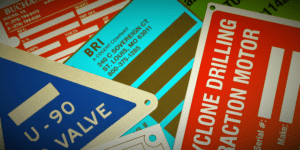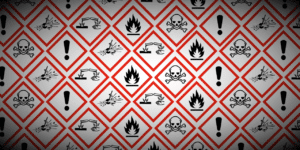What is OSHA?
The Occupational Safety and Health Administration is a government organization which oversees the regulation and implementation of workforce safety spanning across many industries.
Congress established the administration when they passed the Occupational Safety and Health Act of 1970 (sometimes just referred to as the OSH Act).
OSHA has many mandates in place for organizations to follow. One of the main elements of OSHA protocol is providing clear identification and safety signage and tags.
OSHA Requirements for Tagging
Construction Tags
Construction sites can very quickly go from a controlled environment to an incredibly dangerous one if proper safety protocols are not followed.
Sling Tags
Every wire, chain, or rope sling must have a tag on it with specific information.
The sling tag also often includes information for the operator/workers. This can include proper angles, number of legs, and the type of hitch the sling was intended to be used. Workers must ensure they do not exceed the weight restrictions and tolerances listed on the sling. Otherwise, they are putting themselves and other coworkers at risk of injury.
Many OSHA regulations work in conjunction with other industry guidelines and standards. Sling tags are a great example of this. Sling tag markings must also comply with ASME/ANSI standards (B30.9).
Additionally, if the sling tag is not up to the latest standard, the sling itself must be taken out of commission until it is updated with the correct information.
Accident Prevention/Safety Signage
Another common type of identification seen in nearly every type of plant, factory, or other industrial job site is safety signage.
Some examples include:
- Danger Signs
- Accident Prevention
- Safety Instructions
- Warning Signs
- Caution Signs
OSHA sets specific guidelines for safety sign designs. For example, safety instruction signs must have a green panel on a white background, with white text.
Data Code Plates
Applying a data plate to a piece of equipment might not seem significant, but it can make a big difference in the overall safety of an organization.
This is why OSHA has implemented standards mandating the use of this type of nameplate in certain situations.

For example, forklifts are specifically outlined in the 1910.178(a)(4) standard. If the forklift is modified, their data plates must be updated as well. This serves to keep operators informed regarding the equipment they are utilizing.
GHS Labels
OSHA has adapted many of their standards over time to better coexist with other guidelines and regulations. For example, with the introduction of the GHS (Globally Harmonized System) by the United Nations, OSHA decided to align their former HCS (Hazard Communication Standard) with the new global guidelines.

This provides a better sense of clarity instead of forcing organizations to navigate and adhere to numerous standards at once.
Equipment Repair Tags
Equipment tends to break and require repairs from time to time. One of OSHA’s goals is to ensure damaged equipment is not operated, which can otherwise put workers at unnecessary risk. This can lead to injury or further damage the machinery.
Repair tags are used to prevent this from happening. One of their more well-known initiatives, OSHA created the lockout/tagout program to provide a standardized system of equipment repair marking.
Marking Processes for OSHA Tags
Photo Anodization
Photo anodization is a fully customizable marking process. This method imprints a design beneath protective layers of anodized aluminum.
The ability to add nearly any type of information or design makes photo anodized tags highly versatile. From barcoding inspection tags to safety signs with specific imaging, they can cover it all.
While custom information is a must, a safety tag isn’t useful if it will simply fade or wear. Work environments can feature some harsh elements, and ID tags must remain effective in these conditions.
Photo anodized tags are durable enough to withstand heavy wear, potential water or chemical exposure, as well as sunlight and other weather conditions.
The anodized aluminum is lightweight but resilient, and can even be color coded if necessary for a specific safety application.
Digital Printing
OSHA requirements don’t only apply to metal nameplates; they also pertain to labels and other printed signage.
Digital printing is most commonly used for custom label and decal marking. Typically a polyester or vinyl base is printed with topical ink. Various colors and nearly any design can be printed, meeting requirements for GHS or other OSHA labeling standards.
While this process can provide a stand-out appearance, it is not the most durable identification solution. Surface level printing tends to wear and fade faster when exposed to rough industrial conditions.
Wrap-Up
OSHA strives to make work environments as safe as possible for everyone involved. This is especially the case with industrial type operations as the risk for injury can be much greater.
Make sure your organization is compliant with all of the relevant OSHA identification and safety marking standards.